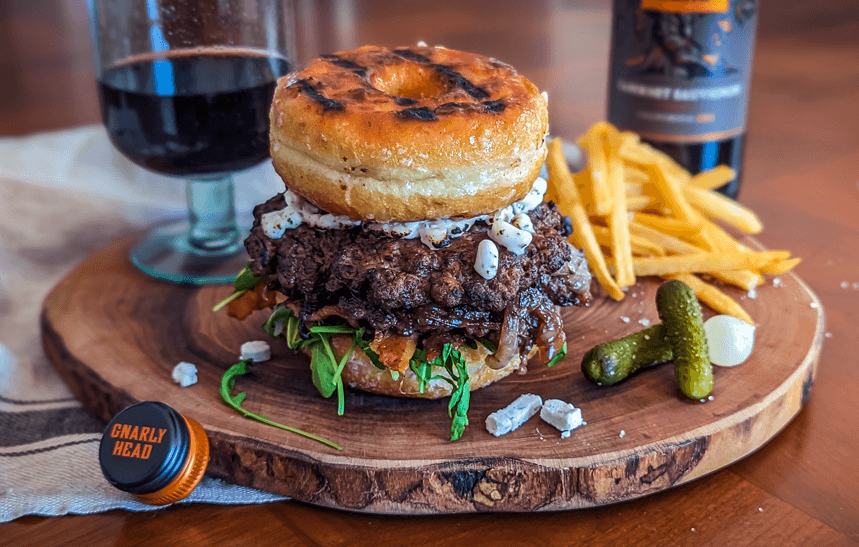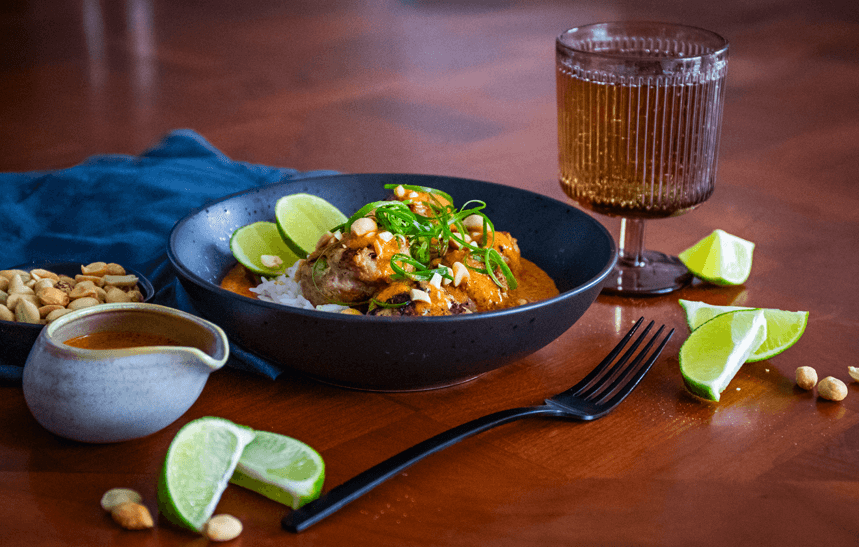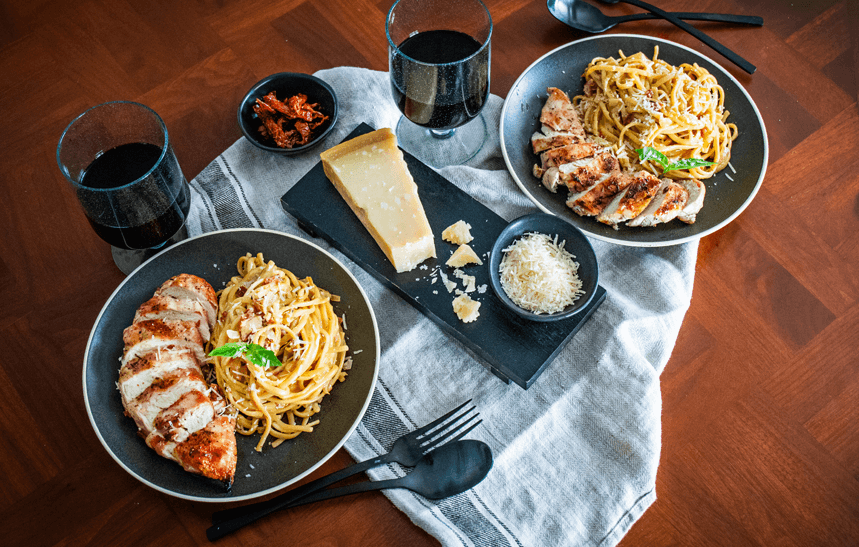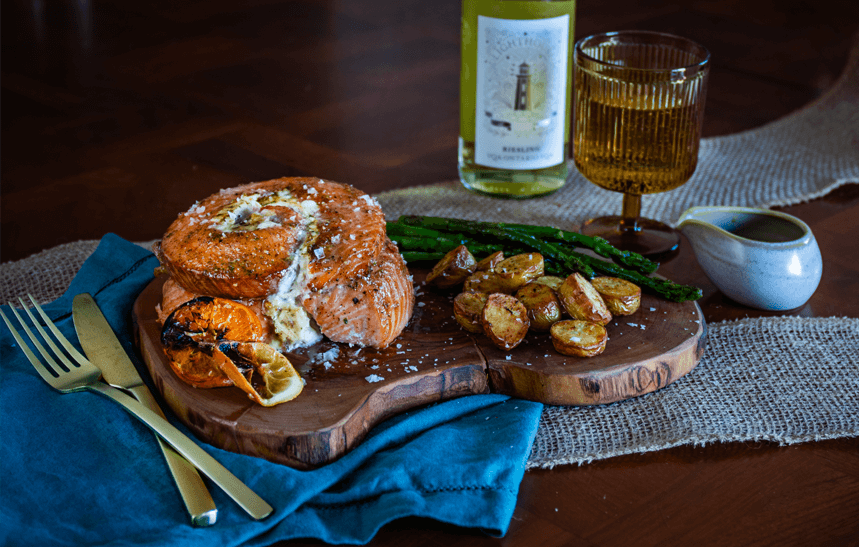
How to Pair Wine with BBQ
One of the most pleasurable things in life is to sit down to a delicious meal and sip the perfect beverage while enjoying wonderful company. The knowledge of how to pair wine with your exquisite, barbecued feast and successfully doing so will elevate things to new heights. Understanding how to taste wine, knowing about the components that make wine, and finally the elements that can help you select the right wine, will ensure that your beverage choices only serve to make your meals even better.
Why do you Want to Pair Wine with Meals?
The idea behind perfect pairings is to enhance your overall experience. It’s like getting the perfect ratio of peanut butter to jelly. The goal is to find a pairing that doesn’t dominate the food but balances it. There should be no overwhelming or underwhelming… you should just be whelmed in a very positive way.
I’m sure you have heard the generalization that Red Wine goes with red meat, while White Wine is best with white meat. But there’s so much more to it than that. There are some reds that you would put with some dishes and some whites you would put with others.
There isn’t really a wrong answer when it comes to pairing beverages, like wine, with food. However, you will find that some wines will make better companions to your meal. Experiencing food and paired beverages together is a completely subjective experience. However, some factors will directly impact how exceptional that experience will be.

How to Taste Wine
Tasting wine is not just slugging it back. Some need to breathe and some need to be experienced in different cups, or at different temperatures. To taste a wine and experience it as it should be, so that you can understand how it pairs with your food, follow these general rules.
- Once poured into a glass, smell the wine. Swirl it in the glass, then smell it again. Swirling can release the aromas of the volatile compounds and add a little oxygen into the mix. This will give you an idea of the wine’s viscosity and the tasting notes you should expect.
- When smelling, place your nose over the glass and inhale deeply. You should smell the fruits that made up the wine, the way or container it was aged in, herbs, the earthiness and minerals within, as well as the possible intensity of the flavours.
- With your nose still in the glass, take a small sip. Roll it around your tongue to taste it. Take a second sip, inhaling as you do to see if the wine changes tasting notes with the addition of oxygen.
- Finally, once you have swallowed, breathe in. You may find more tasting notes in the lingering aftertaste. As the alcohol evaporates it will release volatile compounds which can be detected through taste and smell. Is there something lingering and leaving a pleasant aftertaste?
Wine producers use different vessels to age wine. The oak barrels we are familiar with produces smoky and vanilla scents and flavours, while stainless steel is used when a producer wants to preserve the freshness of the wine. Some winemakers have started to use concrete and clay pots (amphora), which can lend mineral flavours to the finished wine.
Terms Used to Describe Wine
Some wine terms are thrown around and can lead to confusion. Here are a few that will help you speak about the wines you are looking for when choosing a pairing.
Structure
Structure is the relationship between all of the elements that make up a wine. The acidity, the body, the tannins, the sugars, and the alcohol content. These combine to make a substantive whole; the sum of these components makes the wine you are drinking. While structure as a term isn’t used very often when you are asking for a recommended pairing, a wine cannot be judged without this.
When you sip, a well-structured wine will have a weight in your mouth. Not like physically heavy, more like provides a sensation of gravitas through taste. Well-structured wines are best paired with heartier foods.
Dryness is related to the amount of sugar that is left at the end of the winemaking process. This has a direct relationship with the structure of a wine. Dry wines have very little residual sugar, they aren’t very sweet – like a Sauvignon Blanc or Malbec if you are looking for a red. On the opposite side of the scale, a sweet wine will provide fruit-heavy flavours and a dessert-y palette as is the case with Port and dessert or ice wines.
Acid is one of the key structural components of wine and provides the tart or sourness that you experience. Acidity can create brightness or freshness when drinking and will lend that to the pairing that you have made.
Body
Body is measured by the weight, texture, and richness of the beverage.
Light-bodied wines are smooth. They possess a lighter mouthfeel and are higher in acid while being lower in alcohol content. Light-bodied wines also contain fewer tannins and are lighter in colour. Great examples include Riesling, Verdejo, and for red a Pinot Noir.
Medium-bodied wines are middle of the road, they balance the acid, tannins, and alcohol content to create wines that pair beautifully with food because they aren’t overwhelming in one direction or another, making them ideal for an umami-rich meal. When measured by acidity and alcohol content, Merlot is an excellent example of a medium-bodied red wine, while Pinot Grigio is an ideal white.
Full-bodied wines are low in acid, high in tannin, and possess more alcohol and sugar. Full-bodied wines are more likely to be oak-aged to mellow the bold flavours and reduce the astringent qualities. Aging in oak barrels also imparts aromas of vanilla, smoke, and leather. The more body a wine has, the more viscous it is. It will linger on the tongue and in your mouth leaving fragrance and taste. Excellent examples of full-bodied wines are Cabernet Sauvignon for red and Chardonnay for white.
Tannins
Tannins are the drying sensation that you experience, similar to when you drink cranberry juice or black tea. Tannins are created when the juice from the fruit being used in the wine is left in contact with the skins during the winemaking process. Most white wines have very little tannins in them.
Viscosity and Legs
Viscosity in anything is the resistance to flow, not quite thickness, more like syrupiness. When a glass of wine is swirled, the wine should move attractively within, coating the glass in a thin layer of liquid that takes its time to come back to a settled state. The wine that coated the glass then forms droplets that slowly drip down into the settled wine after a sip or swirl. That is the legs of your wine, and it is created by a combination of alcohol evaporating and the surface tension of the wine itself. Full-bodied wines with a high alcohol content will have longer legs and higher viscosity.

Wine and Dine Smash Burgers
Rich in umami flavours, the combination of crispy barbecued beef and creamy blue cheese in these Wine & Dine Smash Burgers pairs perfectly with the dark and bold fruit flavours, tannin heavy feel, and spicy peppercorn finish of the Gnarly Head Cabernet Sauvignon. This pairing is so fantastic, it was even used in the cooking of the meal.
Food Elements and Pairing Wine with Them
The qualities that your planned meals have will directly impact the choices that you make when it comes to wine. Wines that are more structured or have complex flavours, and higher tannins can stand up to foods that have more powerful flavours. The idea is not to lose the wine in the dish or vice versa. Learn more about cooking with alcohol, like wine.
Complement or Congruent
When pairing complementary flavours, harmony is created by using contrasting flavours. For instance, pairing a sweet wine with a salty dish can be delightful if you enjoy that sweet and salty combo. A classic example of complementary pairing is putting a tannin-heavy red wine with a fatty cut of red meat. This can be a challenge, though, as your options will vary depending on personal tastes.
Congruent flavours are ones that match that of a dish. The food and wine will share similar flavour components and will enhance those similar flavours in each other. This is especially effective when pairing acidic or sweet flavours together – like an acidic wine with a vinaigrette salad.
What Grows Together, Goes Together
Much like when you pair cheese with your barbecue, wines from the same regions around the world will go well with cuisine and ingredients that are particular to that area too. The regionality will highlight the similar flavour notes and bring them to the forefront of both the food and the wine together.
Salt
Salty foods pair well with acidic wines like Chardonnay and Champagne. The acidity cuts through the salt and the refreshing flavours balance the salt, making for an even more pleasurable experience.
Sweet
Sweet wines will pair well with salty foods, balancing out the salt and creating a pleasing counterplay.
Sweet wines also pair well with sweet foods; however, the sweetness level of the wine needs to exceed the sweetness of the food being consumed or the wine will taste bitter and metallic. Try a Muscato with your next dessert.
Sweet wines paired with umami and creamy elements like butter can pull out and highlight the savoury elements within the wine you have paired.

Smoky Seared Duck Breast
This is a prime example of growing and going. The Zinfandel used in this recipe for this Smoky Seared Duck Breast recipe comes from California and so do the figs. The dense, blackberry and plum flavours unite with the sweet date-i-ness of the fig while the dryness plays well with the fatty, bacon-like earthiness of the duck.
Umami
Umami is a savoury taste that satisfies and lingers on the palette. It occurs when the compound glutamate is combined with the compounds inosinate or guanylate. Great examples of this would be any combination of tomatoes and cheese, mushrooms and red meat, or even a savoury stew. Beaujolais is a great wine for umami-rich foods. The umami will intensify the bitterness of the tannins in the wine. Umami flavours can also be balanced by a wine with acidic properties like Chenin Blanc for a white selection or Grenache for a red.
Fats
Foods that are deep fried, heavy in cream or cheese – like hollandaise, or heavily marbled meat pair beautifully with high acid wines like Chardonnay or Pinot Noir. The brightness of the wine will behave as a palette cleanser and make you crave another bite of food.
Fatty foods pair well with tannin-heavy wines too. Fat softens the astringent qualities in the tannins, so something full-bodied and rich in flavour like a Cabernet or Syrah will be perfect for steaks, wagyu, and even hamburgers.
Spice
Spicy foods go well with sweet wines in a beautiful yin-yang dance. However, the higher the alcohol content, the more intense the spicy feeling will be. Select wines with lower alcohol content to ensure you are able to enjoy your spicy meal with sips of delicious wine. Try a Pinot Noir for red or a Sauvignon Blanc for white as your pairing.

Thai Meatball Curry
Lemongrass, ginger, and floral notes coupled with sweetness make Gewûrztraminer a contender for pairing with this Thai Meatball Curry recipe, be careful, though, because the higher alcohol levels can up the spiciness of this meal. If spice levels are a concern, a Moscato may be a better choice featuring citrus notes that can enhance the lime and cut the fattiness of the coconut milk.
Acid
Acid, when you eat or drink, is felt with a sour or tart sensation, a rush of saliva, and a pinch in the cheeks. Good sharp cheese or a squeeze of lime juice comes to mind when you think of something acidic. Pair these kinds of flavours with an acidic wine to ensure that the wine doesn’t fall flat. A red like Chianti with tomato-based dishes, or white Grüner Veltliner to go with vinegared fish and chips.
Bitterness
Bitter foods like greens, vegetables, and cranberries will pair better with a low-tannin wine. Red wines are higher in tannins and won’t go as well with foods that have a tendency to be bitter. Instead, go with whites like an Etna Bianco or a Sparkling wine.
Now that you have built yourself a delicious menu it’s time to find a wine to pair with it. Wines that have more structure, complex savour, or tannins can stand up with foods that have complex and powerful flavours. Rich or full-bodied wines will definitely pair beautifully with foods that are rich as well. The idea is to ensure that both harmonize through contrast or comparison to create the most pleasurable experience. You also don’t have to select one wine and stick to it alone for the meal. You may consider something for the starters and something entirely different for the main, and another for the dessert.

Grilled Chicken with Pasta
This recipe for Marry Me Grilled Chicken with Pasta bends the rules, however, the Nero D’Avola red is tannin heavy, pairing well with the deep umami of the sundried tomatoes and parmesan, while the creamy fat of the sauce softens those tannins.
People Also Asked:
What are the Two Basic Rules When Pairing Food and Wine?
There are a couple of basic rules when it comes to pairing food and wine. First, you should pair red wine with heavy sauces and red meat, while white wine goes with lighter foods, salads, and white meat. And second, you need to choose wines that complement the dish or one that will enhance the dish through congruence.
What is the Method for Pairing Wine With Food?
Wine needs to have the same intensity as the food that it is paired with to ensure that neither the food nor the wine overshadows each other. Light wines like Pinot Grigio with a refreshing salad of greens while a red Syrah will pair better with the roasted flavours of barbecue.
What Wines Pair Well With That Foods?
White wines will go well with light foods, salads, white meats and fish, and creamy pasta sauces, while reds can handle heavier things like steaks and red meats, and rich desserts. These rules are meant to be bent when possible. As long as you know the main components of the meal you are creating, you can take liberties with the rules for a unique pairing.
What is the Basic Rule to Wine and Food Pairing?
- Salty, pair with sweet wines
- Sweet, pair with sweet wines but the wine must be sweeter than the dish
- Umami, pair with tannin-heavy or acidic wines
- Fatty, sparkling or acidic wines are best to cut the richness
- Spicy, low alcohol content with sweet flavours is best
- Acidic, pair with an equally acidic wine
- Bitter, pair with low-tannin wines
How Does this Translate to BBQ?
The big question is, how does all of this information translate to that barbecue feast that you have planned? The optimal outcome is that you enhance the overall experience with wine. This means that you need something to match the intensity of your meal. Wine should be considered an accessory to your meal and the addition of this will bring your meal to a perfect whole.
So, consider a local wine when you shop for local produce. If your dish is deeply umami-based, an acidic or tannin-forward wine will be great. If you have a sweet BBQ sauce on your food, remember that the wine should probably be sweeter than the sauce. Finally, take risks, break rules, and above all, have fun finding the perfect wine pairings for your summer barbecue.
Now that you know how to pair wine with BBQ meals, what will you be serving at your next cookout? Share your perfect pairings with us on our social pages like Facebook and TikTok using the hashtags #NapoleonEats and #NapoleonGrills.

This is where understanding comes into play. This recipe for Salmon Pinwheels features fatty fish and creamy cheese melded with smoke and a sweet glaze. While Reisling, pictured here, is an acceptable choice due to the tart zestiness and high acidity which plays nicely with the fat and creamy cheese, it is a safe choice. A Chardonnay could be an alternative due to its full-bodied nature and playing well with both salt and fat.